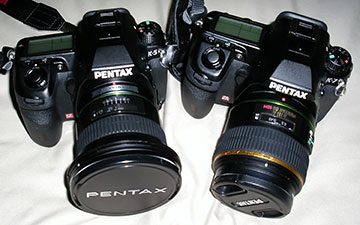Although I’m sure you can tell from the example images I’ve shown previously, I thought I might as well include a section on my equipment to provide some background information. My gear is actually pretty unique compared to what most photographers are sporting, but that has been the case in most things I do. I primarily use Pentax DSLR cameras and prime (fixed focal length) lenses. Often, I don’t even bother using an external flash as I can “get away with” not using it in many situations. The reason I chose Pentax SLRs around 2005 was because they tend to be smaller than competing offerings yet offer the same or more features as those larger models. They also tend to be very ergonomic in how they function, making it easy for me to properly control the camera in all situations. My two current camera bodies are the Pentax K-5 (16 MP Sony sensor) and Pentax K-7 (14 MP Samsung sensor), which are the fully weather sealed pro-level bodies, have a very quiet mirror/shutter, have internal shake reduction, and are primarily covered in magnesium alloy around a steel frame. Their viewfinders have a 100% view at 0.92 magnification, meaning everything I see in the viewfinder will be exactly what is in the resulting image. These two bodies are physically the same and use the same batteries, so I’m able to switch around accessories and have a stock of batteries that work with both.
I primarily use prime lenses, which I like to call a “lifestyle choice” as they can be geared more toward the specialty end of image capture. I can’t say I really have one set reason I prefer primes, but it comes down to aspects like physical size, large aperture, high sharpness, and a certain way prime lenses allow me to focus my abilities as a photographer. I’m less interested in standing in one spot when using a prime, so it forces me to look for different angles and points of perspective that will maximize the quality and interest of my resulting images. Now don’t get me wrong, I do enjoy zoom lenses and certainly see them as an option in many situations such as when photographing masquerade events on stage were I need to stay in one position.

Sometimes when shooting primes, I use two camera bodies at once, which I like to call “dual wielding” in homage to FPS video games where the term became popular. It usually goes down like this… My primary camera body has a wide angle prime lens with a standard neck strap. The second camera body has a hand strap and a wide aperture lens in the 50-70mm range attached. I have a single camera holster style shoulder bag where I store my second camera. While walking around the convention I hold the “portrait camera,” as I like to call it, in my hands so it is instantly ready once I find someone to photograph.
Once I take a few shots with that camera, I quickly put it back in my bag and start shooting with the primary wide angle camera. While I will admit it is a little challenging getting people to realize I am going to take photos of them with two separate cameras, it results in a large variety of images without having to worry about changing camera lenses in the field (one negative of specialty prime lenses). When I’m not up to using two cameras, I use a single wide aperture prime lens in the 30 – 35mm range for use on APS-C sized cameras (eg. for full-frame, use something around 50mm). That focal length is wide enough and long enough for pretty much any close range style of photography as long as I have room to maneuver for full body shots.
- Overview
- Who is this for?
- What is convention photography?
- My experience and experiences
- Why be a part of this?
- Practice, practice, practice!
- Networking
- Fun
- Photography terms primer.
- Equipment
- It is important or not depending on your ideals
- A basic setup.
- Decide how you want to make it work.
- Framing and composition
- Full body shots.
- Portrait style.
- Skewed angles.
- Face in detail.
- Plane of focus.
- Rule of thirds and golden ratio
- Available light photography.
- Strobe photography.
- Removing harsh light.
- Flash brackets.
- Bokeh and blur maximization.
- Histogram reading and image review.
- Post processing.
- Various schools of thought.
- Available software on your OS of choice.
- Ideas on how to improve your processing.
- Business cards.
- Social networking.
- Website
- The process from start to finish.
- My equipment.
- Ask the person first.
- Interrupting people.
- Constrained areas.
- Physical activity.
- Summary
